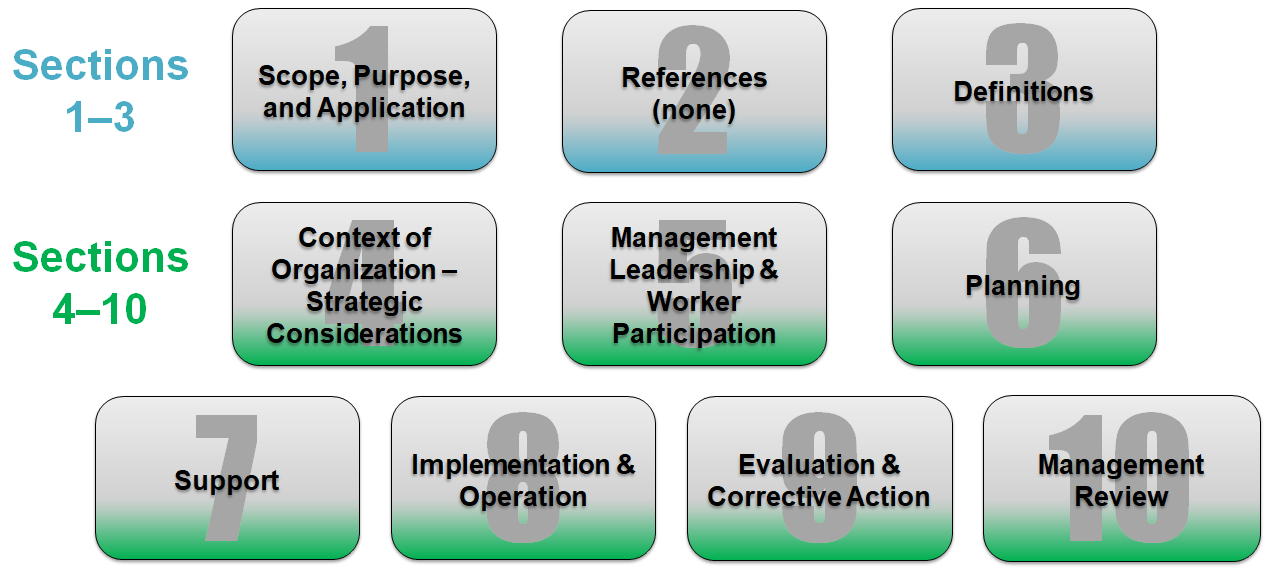Scope:
ANSI/ASSP Z10.0, Occupational Health and Safety Management Systems (OHSMS), is a voluntary consensus standard providing a framework for management system principles and guidelines for occupational health and safety (OHS) among American organizations. It uses recognized management system principles to be compatible with quality and environmental management system standards such as International Organization for Standardization (ISO) 9001, ISO 14001 and ISO 45001. ANSI/ASSP Z10.0 focuses the strategic levels of policy and the processes to effectively carry out the policy.
ANSI/ASSP Z10.0 establishes OHSMS criteria aimed at helping reduce the risk of occupational injuries, illnesses, and fatalities to improve worker health and safety. ANSI/ASSP Z10.0 follows the Plan-Do-Check-Act process of continuous improvement and serves as an effective way for organizations to improve OHS performance.
Organizations must establish their own policies, procedures, and instructions and demonstrate how their processes establish an effective OHSMS, as the standard does not provide detailed procedures, job instructions, or documentation mechanisms. However, the ANSI/ASSP 10 committee published a Guidance Manual containing suggestions on implementing and maintaining an effective OHSMS.
Potential benefits: An organization may already have some elements of a management system in place. However, the system and its elements may be informal and focused primarily on traditional OHS compliance programs. A formal OHSMS integrates specific OHSMS elements into key business practices and organizational operations where they may be missing and/or help drive the overall organization further down the path of continual improvement. Sections of Z10 parallel the high-level structure of ISO 45001.
Click on the the sections graphics below to jump to its description.

Section 4 – Context of the Organization – Strategic Considerations
Requires the organization demonstrates they understand their organization and the needs and expectations of workers and interested parties. Section 4 also specifies the scope of OHSMS shall be documented.
Section 5 – Management Leadership & Worker Participation
Defines the requirements of management leadership and worker participation. It provides key actions top management shall take to include establishing a documented policy, communication to workers, responsibilities, authority, and worker participation throughout the various levels of the organization in support of the OHSMS.
Section 6 – Planning
Defines the strategic and planning requirements of the organization’s OHSMS and references how operational (tactical equipment/task level process) planning takes place within every section, and emphasizes planning is ongoing and reoccurring, not a one-time event. This section also defines how the organization shall continually review, assess, prioritize, document objectives & implementation plans, and allocate appropriate resources.
Section 7 – Support
Defines requirements the organization shall have to support and achieve an effective OHSMS, covering topics including: resources, education, training, awareness, communication, and document control processes.
Section 8 – Implementation and Operations
Defines the operational elements the organization shall have to implement, control, and maintain an effective OHSMS. These elements include: operational planning, control identification of issues, deficiencies, opportunities, legal requirements, risk assessment, application of the hierarchy of controls, management of change, procurement, contractors, occupational health, and emergency management.
Section 9 – Evaluation and Corrective Action
Defines how the organization shall evaluate performance of their OHSMS, including: monitoring, measuring, assessing results to include incident investigations, audits, corrective actions, feedback, and lessons learned.
Section 10 – Management Review
Requires the organization shall have a periodic top management review process in place to review the outcomes of their OHSMS and drive follow-up actions as necessary.
Annex A – Guidance
Annex A is not comprehensive; however, it provides information and material the committee feels users will find helpful to provide additional clarification in support of the sections. It does not contain requirements of the standard.